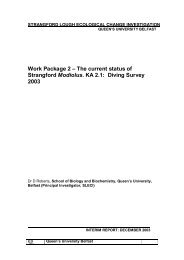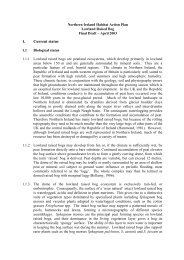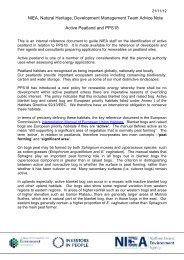Municipal Waste Data Monitoring and Reporting: Interim Guidelines
Municipal Waste Data Monitoring and Reporting: Interim Guidelines
Municipal Waste Data Monitoring and Reporting: Interim Guidelines
You also want an ePaper? Increase the reach of your titles
YUMPU automatically turns print PDFs into web optimized ePapers that Google loves.
3.6 WASTE MANAGEMENT PLAN TARGETS – CRITICAL PATHS, TRIGGER POINTS &<br />
CONTINGENCY PLANS (STEP 4)<br />
The procedures described in the first three steps outlined above all relate to<br />
activities at the District Council level. The next two steps outlined below are<br />
to be implemented at the Group level.<br />
Regular monitoring <strong>and</strong> measurement of progress towards achieving the<br />
<strong>Waste</strong> Strategy Targets is fundamental to the success of the <strong>Waste</strong> Management<br />
Plans. In view of this, the <strong>Waste</strong> Management Groups will need to identify the<br />
WMP Targets that relate to their waste collection <strong>and</strong> processing streams, <strong>and</strong><br />
the relevant KPIs <strong>and</strong> datasets for these streams.<br />
After breaking down the targets into various streams, the <strong>Waste</strong> Management<br />
Groups should then develop a monitoring programme incorporating the<br />
following key components:<br />
• Critical Paths – setting out the timescales by which key activities necessary<br />
for the achievement of the WMP Targets should be completed;<br />
• Trigger Points – these should be clearly defined parameters or values (e.g.<br />
recycling rate for a particular waste stream or site) for critical KPIs, <strong>and</strong><br />
should be set at such a level that will alert the Group (or an individual<br />
District Council, as appropriate), where performance falls short of the<br />
WMP targets;<br />
• Contingency Plans – corrective actions that can be taken to bring the<br />
programme back on track, once a trigger point is reached (i.e. performance<br />
is falling significantly behind the planned levels).<br />
3.7 KPIS, MONITORING AND REPORTING (STEP 5)<br />
The formulae for calculating the KPIs (as shown in Annex D) have been<br />
entered into Microsoft Excel worksheets, which are provided on floppy disc at<br />
the back of this document. Instructions for use are outlined in Annex G. The<br />
worksheets describe the data required for determining each KPI <strong>and</strong> are based<br />
on the same format used by the Department for the Annual <strong>Municipal</strong> <strong>Waste</strong><br />
Surveys. Regular collection <strong>and</strong> validation of data will enhance the quick <strong>and</strong><br />
efficient calculation of KPIs.<br />
Two categories of reports are required, as follows:<br />
3.7.1 Quarterly Reports<br />
The KPIs listed in Annex A should be calculated every quarter for each District<br />
Council <strong>and</strong> then amalgamated for each sub-regional waste management<br />
planning group. Concurrently, the <strong>Waste</strong> Management Groups (<strong>and</strong><br />
individual District Councils) should check <strong>and</strong> review their performances<br />
against planned levels <strong>and</strong> identify <strong>and</strong> initiate corrective action as<br />
appropriate, where required.<br />
MUNICIPAL WASTE DATA MONITORING AND REPORTING: INTERIM GUIDELINES 10

















